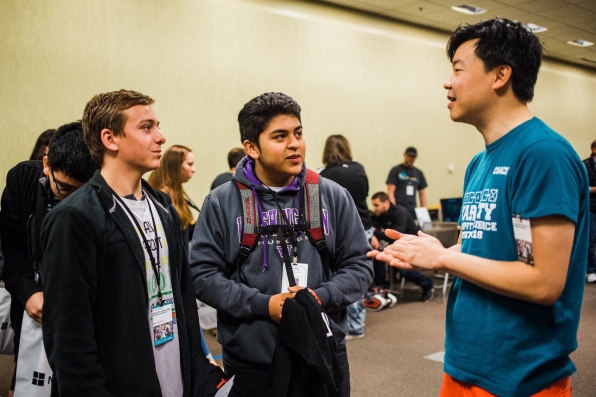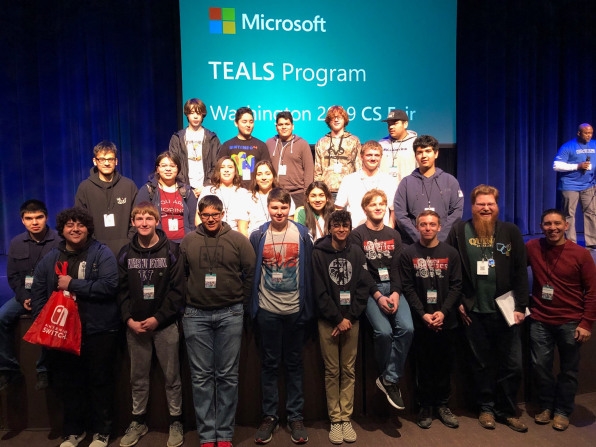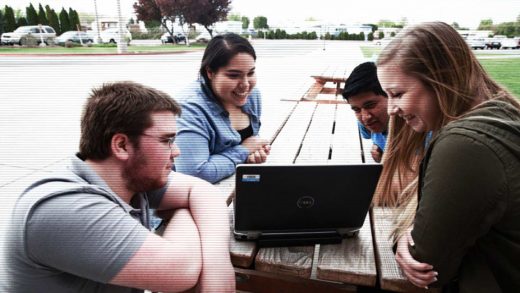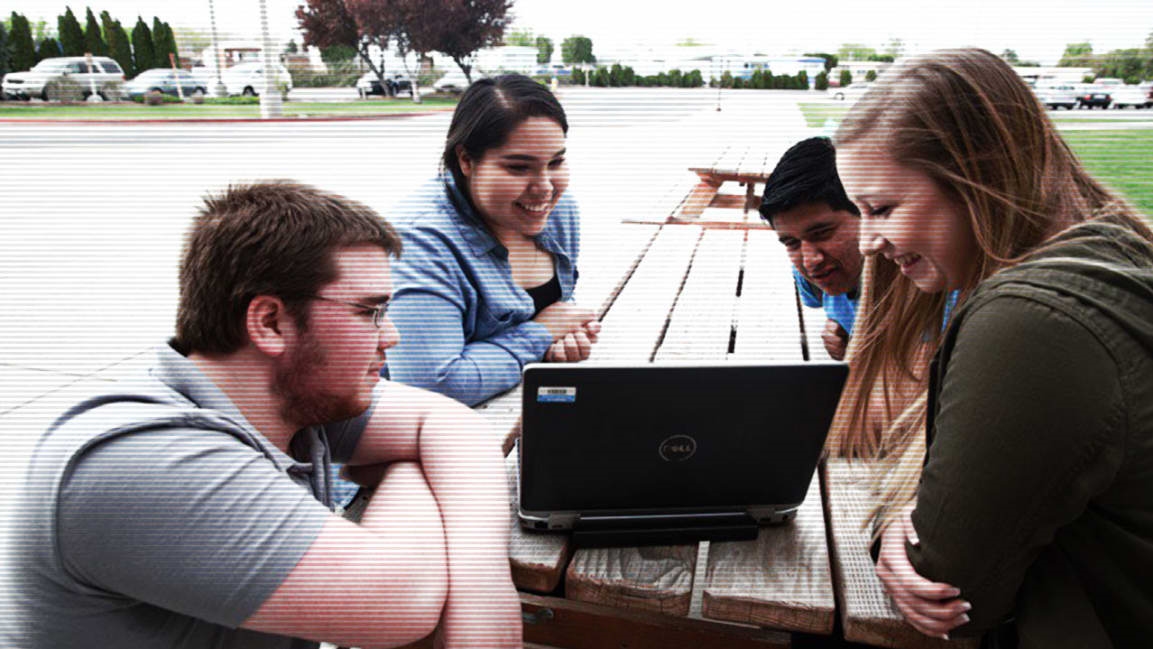How the tech industry created a teaching corps for rural schools
Gonzalo Birrueta didn’t just like playing video games as a kid; he liked thinking about how they were made. In middle school, he’d experiment with coding, watching YouTube videos for help. But it was easy to lose motivation—he didn’t have many people he could talk to about coding in Quincy, a rural town of 7,000 perched above the Columbia River in Central Washington state.
Computer science offerings have grown over the past 10 years, but rigorous courses can be hard to come by, especially in rural areas. While 58% of rural schools report teaching some type of computer science class, less than half of those actually teach coding, and only 8% offer an Advanced Placement option.
But when Birrueta arrived at Quincy High School, he had several computer science classes waiting for him. Quincy had just partnered with TEALS, a free program run by Microsoft Philanthropies that trains tech industry employees to teach computer science lessons in partnership with classroom teachers.

[Photo: Mark Kondo]
The TEALS model addresses one of the largest barriers school leaders cite to being able to teach computer science: finding experienced teachers. After TEALS volunteers co-teach with classroom educators over the course of several years, those teachers feel confident enough to lead computer science classes on their own.
Now 10 years old, TEALS (Technology Education and Literacy in Schools) reached nearly 500 schools this academic year across 27 states, D.C., and British Columbia, or 15,500 students. Its more than 1,400 volunteer teachers hail from hundreds of tech companies, including Microsoft, Google, Facebook, and Amazon. Several volunteers partner with one school where they alternate teaching each day for an hour in the morning before heading to work.
But because most tech industry employees live in large cities, TEALS had to rethink how to deliver instruction to students in rural schools. For these students, TEALS instructors teach lessons over video conferencing, where students can chat back and forth with their teacher. For example, an Amazon employee based in Seattle teaches Birrueta’s class in Quincy every morning at 8:05 a.m. before he starts work at 10.
“We want to make sure that kids in rural areas, just because they’re born in a different zip code, get the same opportunities as kids in other areas,” said Kevin Wang, TEALS founder and a former Microsoft engineer.
And students like Birrueta, now a senior, say the program has made an impact on their lives, introducing them to new careers, new cities, and new ways of thinking.
“Not only does computer science teach you the technical things, it teaches you to problem solve in real life as well as think more critically,” Birrueta said. “I do think it should become a requirement to at least take an intro class to get exposure and to know that it’s there.”
A rural school with a computer science track
Lee County High School in Beattyville, Kentucky, was one of the first rural schools to sign up for the program in 2012. It’s now considered a TEALS alumni school, meaning that the classroom teacher runs the TEALS program without the help of volunteers. Since the TEALS partnership, Lee County High School has transformed, hiring a full-time teacher dedicated to computer science and creating a career track for students in computer science so they can take multiple classes over four years. About 65 students, or 20% of the student body, take computer science classes.
“It’s one of the best career pathways we’ve been able to provide our kids,” district superintendent Jim Evans said.
TEALS bases its introductory course on UC Berkeley’s class called, “The Beauty and Joy of Computing,” while its AP Computer Science A class is based on University of Washington’s intro class.
Adrianne Roberts, a senior at the high school, is now taking her fifth computer science course. She’s working on a project right now that involves using multiple coding languages to create a tourism website for her town. While she doesn’t know if she’ll pursue computer science as a career, she likes how useful it will be for most jobs.

[Photo: Courtesy of Microsoft]
“You have to think in a different way than you do in other classes,” Roberts said. “There are so many different ways to solve a problem. It’s interesting to see how other people do it compared to how I do it.”
Giving students the opportunity to take these classes while in high school lets them discover their interests earlier, or find out if the subject is not for them, computer science teacher Joy Neace said.
“It allows students to know, ‘This might be for me,’ or, ‘Hey, I can save money and not take these classes,’” she said.
The district had to be very active in applying for grants to help fund computers and infrastructure, said William Owens, chair of the Lee County school board. He said the community has been supportive of the new computer science courses, and only occasionally does he hear concerns about brain drain, or the idea that students will permanently leave the community to go use their new skills in city tech hubs. The county’s top three employers are the Lee Memorial Health System, the school district, and Publix supermarket.
“We’ve had several kids who have gotten decent jobs through the program and I’m just supportive of anything that helps the kids,” Owens said.
Wang said that when he hears concerns from the community about brain drain, he points out some of the tech needs community members might not know they have, from farms that are looking for software engineers to run their technological agriculture needs to local businesses that are trying to grow. TEALS is also working with Microsoft’s TechSpark, a program that is trying to help businesses in small towns use digital tools to help reinvent and expand their local industries.
Extreme volunteering
It was a little weird at first. That’s how most students in rural schools described the experience of having their computer science teacher projected onto a screen. But after a while, they got used to it, and many said they began to see the volunteers not just as teachers, but as mentors.
Wang calls the volunteers’ work “extreme volunteering,” for the nearly 200 hours they commit to their students over the course of the school year. They also go through 40 hours of training before they’re placed in the classroom, where they learn everything from how to break down problems with high school students to making lessons fun and relevant. The volunteers and classroom teacher also meet to decide how they’re going to co-teach and plan lessons.
Matt McKee, a software engineer at Amazon, volunteer teaches at Quincy High School. While most TEALS volunteers work a few days a week, McKee teaches every morning. McKee said he is motivated to give back because of all the mentors he had growing up who introduced him to computer science.
“I love the program, I love working with the students, and I love the impact you make on the school,” McKee said. “The students are fantastic too. Every year I’ve had incredible students who tackle hard challenges and don’t hesitate to dive into the material.”
Zack Reynolds, also a senior at Quincy High, credits all of his teachers as having a meaningful impact on his computer science trajectory. Reynolds has built his own programs to help him study for other classes like Spanish or math. His classroom teacher, Mark Kondo, said Reynolds comes early to computer science class just to read a textbook on Java, which he jokingly refers to as the Bible. Reynolds and his classmate Jayr Gudino both earned a spot last summer at Carnegie Mellon University’s highly competitive coding camp. McKee travelled with the students on their first airplane trip to Pittsburgh to help them get settled, and Microsoft funded the experience for both students.
For rural schools that have a large low-income population, other circumstances can compete with a program like TEALS. Some students don’t have internet access or laptops at home, which means in some classes, teachers have to be mindful not to give assignments that require significant homework. Students at Quincy High School take field trips to the Seattle area for TEALS conferences, but some of their peers can’t attend because they are expected to take care of siblings at home.
Mark Kondo, the classroom teacher at Quincy, has been moved by the attentiveness and generosity of the TEALS volunteers to student needs. Some bought laptops for the students that they could check out of the classroom and take home to practice coding. The volunteers also travel the 160 miles from Seattle to Quincy about once a quarter to meet the students in person.

[Photo: Mark Kondo]
“We’re remote and rural, so for (my students) to interact with software engineers is something they would never do if not for TEALS,” Kondo said. “It opens up their eyes to the world.”
Having teachers who also work daily in the tech industry gives students connections to careers. Birrueta learned about the Make School in San Francisco from one of the volunteers, a school that gives hands-on computer science training to students. That inspired him to spend a year saving his money from packaging apples so that he could attend their summer computer science program in the Bay Area. Now a senior about to graduate, Birrueta plans to return and earn a bachelor’s degree in computer science to become an engineer.
TEALS has even seen some of its former students become volunteer teachers. Nathalia Scrimshaw went from being a TEALS student in Bellevue, Washington, to now working as a TEALS volunteer for Chelan High School in Central Washington in addition to her full time job as a program manager in Microsoft’s Xbox division.
Scrimshaw said the TEALS curriculum is both adaptive to the changing technology landscape as well as the diverse group of students it serves. Scrimshaw participated in a TEALS training over the summer about culturally responsive teaching and was able to put her Spanish-language skills to use in the classroom to better connect with her students who were learning English.
“For me, it was about giving back to the community,” Scrimshaw said. “If I hadn’t had TEALS in my own life, I wouldn’t be where I am today.”
Computer science is for everyone
Christian Rivera first became interested in how computers work during a year when he lived in Mexico. The only access he had to a computer was the one at the local coffee shop, which was consistently broken. If you want to use it, you have to fix it, the store owner said, and eventually, at age 13, Rivera did.
Even after that, Rivera didn’t have much experience with coding before he started high school and began taking TEALS courses at Quincy, but he said he wanted to challenge himself.
“When I started taking the class, the TEALS teachers started explaining to us that computer science is the future … so that pushed me to try my best,” Rivera said.
Schools across the country also acknowledge this future—nearly 750 applied to be part of the TEALS program for this next academic year, though only 600 will be able to participate. Expanding the program often depends upon the availability of volunteers.
As TEALS grows, Wang hopes to spread the program to more rural schools. Right now about 20% of schools that participate are rural (or 89 schools), though Wang hopes to increase that to 25% soon. In the U.S., 28% of all U.S. schools are classified as rural, according to the most recent federal data. They also want to ensure a more equal gender balance. Currently 34% of TEALS students are female, an increase from 25% four years ago.
The students are advocates for getting more of their peers involved as well. Rivera and Birrueta both say computer science is for everyone, not just the kids who are viewed as good at math and science. When the classes get tough, Rivera recalled some advice his volunteer TEALS teacher passed on to him.
“‘Just because the code doesn’t work, doesn’t mean it’s completely wrong,’” his teacher told him. “She then told us, ‘Just because it doesn’t work doesn’t mean you should stop trying. It’s not wrong to make mistakes because that’s what life is.’”
This article was also published at The74Million.org, a nonprofit education news site.
(41)



